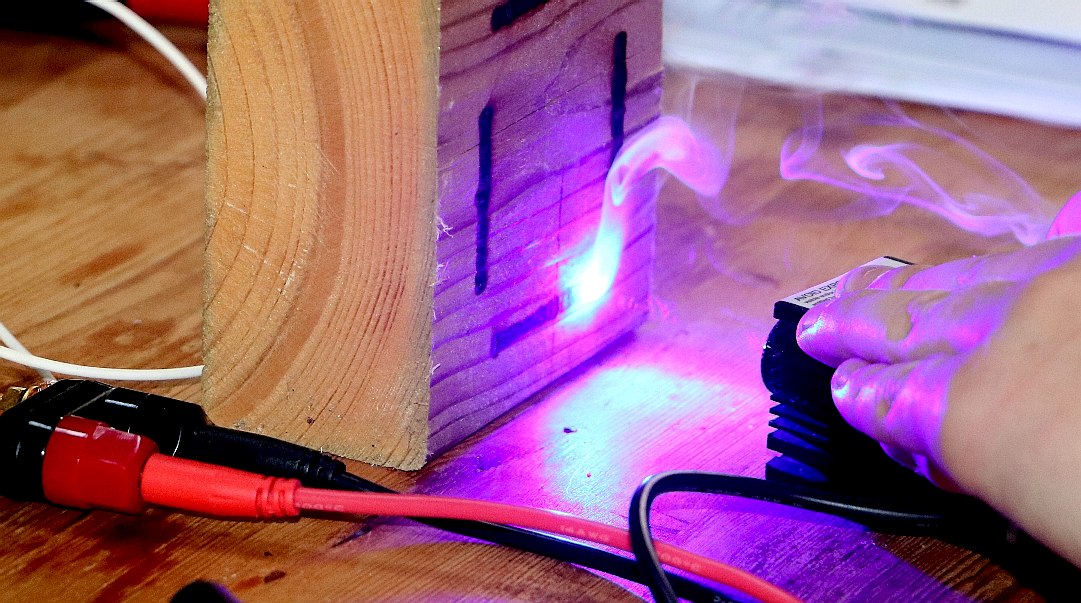|
LASER: EXPERIMENTS AUGUST 22nd 2021
PLEASE USE OUR A TO Z INDEX TO NAVIGATE THIS SITE OR CALL HOME
|
|
|
LASER CUTTING - My first time experimenting with a laser, in the canteen at our workshops in Herstmonceux, Sussex.
It was on Sunday the 22nd of August 2021, when I first discovered what fun lasers can be. We used an ordinary 12 volt motorcycle battery as the power supply, connected to a temporary wiring rig, with a convenient switch, so that we could easily disconnect the power source.
We always keep a few lead-acid batteries on trickle charge, using solar panels. Some are deep cycle leisure, some car starter, and two are small motorcycle batteries. They are handy to power hydraulic power packs, and of course as replacements as older vehicle batteries reach the end of their working lives.
Fortunately, the same day we had been to a supermarket and were very lucky to find and purchase some crocodile clips at a very good price.
We found that this laser could literally burn through cardboard in a second or two. Then we tried wood, and that too was ignited easily.
Metal proved to be a more difficult as was plastic with foil film.
BLUE LIGHT - Always wear safety glasses when working with lasers. Never look directly at laser light, it will blind you and cause serious retinal damage. In this picture I am writing my name.
This is only a 2.5 watt laser. Some lasers used on ships as weapons are many kilowatts. But they are not very effective through the atmosphere, and through water are absolutely useless - with no penetration power at all. They would work better is space.
|
|
|
When experimenting like this, it is a good idea to know how to rig up a temporary wiring loom and circuit breaker. We used whatever was lying around in the workshop, and some salvaged parts from a mains powered power supply that had been blown up. It's called recycling.
The basic skills are cutting wires to size, baring the ends, and connecting up in a logical fashion, safely. There is a right and wrong way, as I soon discovered. We did not want to get the soldering iron out for this little project. It would have slowed us down.
REMOTE CONTROL
The next logical step in this series of experiments, is being able to sight accurately, using servos and a radio control set. I'd also like to find out how well they work at distances of 25 - 100 meters or more.
No idea at this stage what practical use can be made, other than warning off wildlife. And for that we'd need a sensor to trigger the detection and aiming function, plus vision to assist targeting, not wanting to actually hit the target, just fire a warning burst close by. Cattle are controlled using electrified fences, with a shock that does them no harm. Foxes and the like are frightened away by controlled burst of water, also using infra-red sensors to detect their movement, then trigger a shower for the unsuspecting animal.
Green laser light temporarily blinds humans, so could be useful as a deterrent against unwanted intruders. For example, to ward off pirates at sea. Hence, this project my eventually lead to an accessory on the Elizabeth Swann.
One film where a submarine used high voltage electricity to fend off a giant squid, and cannibals, was 20,000 Leagues Under the Sea, by Jules Verne.
A very quickly assembled wiring rig using crocodile clips. We spliced into the laser cables, being very careful not to cut all the way through the insulation. Just in case we needed the supplied connector, later.
|
|
|
This website is Copyright © 2023 Planet Earth Trust.. The design of the AmphiMax as featured on this website is subject to design copyright © with all rights reserved - unless stated otherwise.
|



